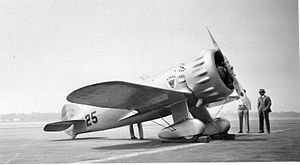Wedell-Williams Model 44
| Wedell-Williams Model 44 | |
|---|---|
 |
|
| NR61Y, Roscoe Turner's Model 44 | |
| Role | Racing aircraft |
| National origin | United States |
| Manufacturer |
Wedell-Williams Air Service Corporation Patterson, Louisiana |
| Designer | James R. Wedell |
| First flight | 12 January 1930 |
| Introduction | 13 June 1930, New Orleans Air Races |
| Retired | 1939 National Air Races |
| Status | One survivor, Crawford Auto-Aviation Museum, Cleveland, Ohio |
| Primary users | Wedell-Williams Air Service Corp. Roscoe Turner Mary Haizlip |
| Produced | 1930-1931 Patterson, Louisiana |
| Number built | 4 |
| Unit cost |
est. US$10,000 in 1931
|
| Developed from | Wedell-Williams Model 22 |
The Wedell-Williams Model 44 is a racing aircraft, four examples of which were built in the United States in the early 1930s by the Wedell-Williams Air Service Corporation. It began as a rebuilding of the partnership's successful We-Will 1929 racer, but soon turned into a completely new racing monoplane aircraft, powered by a large radial engine. Model 44s became the dominant racers of the 1930s, setting innumerable records including setting a new world speed record in 1933.
The only surviving Model 44 is on display at the Crawford Auto-Aviation Museum, Cleveland, Ohio. Three replica Model 44s are on display at the Louisiana State Museum, Patterson, Louisiana.
Experienced air-racer Jimmy Wedell formed a business partnership in 1929 with millionaire Harry P. Williams after giving him flying lessons. Initial plans were to teach flying, provide an aerial photography service and win an airmail contract. Wedell's passion for air racing led him to convince Williams to build a racer for the January, 1930 Miami Air Races.
This first aircraft was named "We-Will" but as development and testing continued it became apparent it would not be ready for the 1930 Miami event. Wedell halted development of the "We-Will" design and began a new aircraft, the "We-Winc".
In parallel to the development of the We-Winc, Wedell began the construction of a third aircraft, the "We-Will Jr." This aircraft first appeared in the Cirrus Derby held in Detroit on July 21 but the design proved to be underpowered. Further development with improved aerodynamics, numerous technical innovations and a Hamilton Standard ground adjustable propeller radically changed the aircraft's appearance. Incorporated into the design were the wheel spats that would be an iconic feature of the future racers. It was a typical construction with a braced, low-wing monoplane utilizing fixed landing gear in large spats. This version was however also underpowered. In development and in competition this version, by now dubbed "Model 22" proved to be a disappointment and further development was abandoned.
...
Wikipedia
